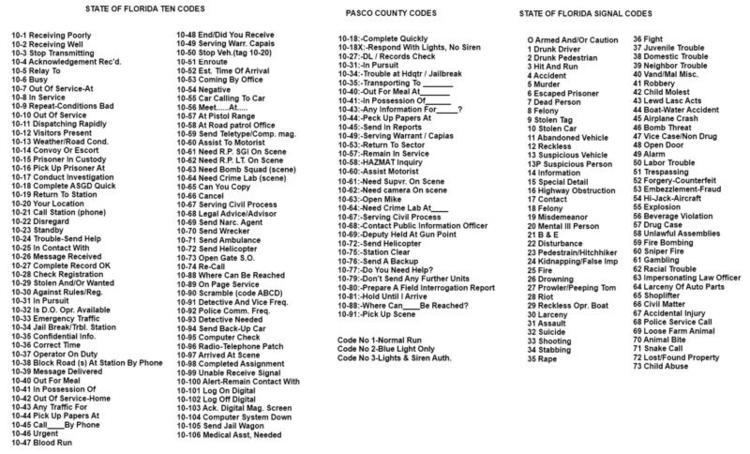 | ||
Ten-codes, officially known as ten signals, are brevity codes used to represent common phrases in voice communication, particularly by law enforcement and in Citizens Band (CB) radio transmissions.
Contents
- History
- In popular culture
- Replacement with plain language
- Examples of ten codes
- Related codes
- References
The codes, developed in 1937 and expanded in 1974 by the Association of Public-Safety Communications Officials-International (APCO), allow brevity and standardization of message traffic. They have historically been widely used by law enforcement officers in North America, but, due to the lack of standardization, in 2006 the U.S. federal government recommended they be discontinued in favor of everyday language.
History
APCO first proposed Morse code brevity codes in the June 1935 issue of The APCO Bulletin, which were adapted from the procedure symbols of the U.S. Navy.
The development of the APCO Ten Signals began in 1937 to reduce use of speech on the radio at a time when police radio channels were limited. Credit for inventing the codes goes to Charles "Charlie" Hopper, communications director for the Illinois State Police, District 10 in Pesotum, Illinois. Hopper had been involved in radio for years and realized there was a need to abbreviate transmissions on State Police bands. Experienced radio operators knew the first syllable of a transmission was frequently not understood because of quirks in early electronics technology. Radios in the 1930s were based on vacuum tubes powered by a small motor-generator called a dynamotor. The dynamotor took from 1/10 to 1/4 of a second to "spin up" to full power. Police officers were trained to push the microphone button, then pause briefly before speaking; however, sometimes they would forget to wait. Preceding each code with "ten-" gave the radio transmitter time to reach full power. An APCO Bulletin of January 1940 lists codes assigned as part of standardization;
The Ten Signals were included in APCO Project Two (1967), "Public Safety Standard Operating Procedures Manual", published as study cards in APCO Project 4 (1973), "Ten Signal Cards", and then revised in APCO Project 14 (1974).
In popular culture
Ten-codes, especially "10-4" (meaning "understood") first reached public recognition in the mid- to late-1950s through the popular television series Highway Patrol, with Broderick Crawford. Crawford would reach into his patrol car to use the microphone to answer a call and precede his response with "10-4".
Ten-codes were adapted for use by CB radio enthusiasts. C. W. McCall's hit song "Convoy" (1975), depicting conversation among CB-communicating truckers, put phrases like 10-4 and what's your twenty? (10-20 for "where are you?") into common use in American English.
The movie Convoy (1978), loosely based on McCall's song, further entrenched ten-codes in casual conversation.
Replacement with plain language
While ten-codes were intended to be a terse, concise, and standardized system, the proliferation of different meanings can render them useless in situations when officers from different agencies and jurisdictions need to communicate.
In the fall of 2005, responding to inter-organizational communication problems during the rescue operations after Hurricane Katrina, the United States Federal Emergency Management Agency (FEMA) discouraged the use of ten-codes and other codes due to their wide variation in meaning. The Department of Homeland Security's SAFECOM program, established in response to communication problems experienced during the September 11 attacks also advises local agencies on how and why to transition to plain language, and their use is expressly forbidden in the nationally standardized Incident Command System, as is the use of other codes.
APCO International's current position states that plain speech communications over public safety radio systems is preferred over the traditional 10-Codes and dispatch signals, As of 2011, ten-codes remain in common use in many areas, but are increasingly being phased out in favor of plain language, with nineteen states planning to change to plain English as of the end of 2009.
Examples of ten-codes
Some examples of the codes are:
Many additional codes have been added by individual local or regional first-response agencies; these are not standard across jurisdictions and may be problematic if multiple organizations must respond to the same incident.
